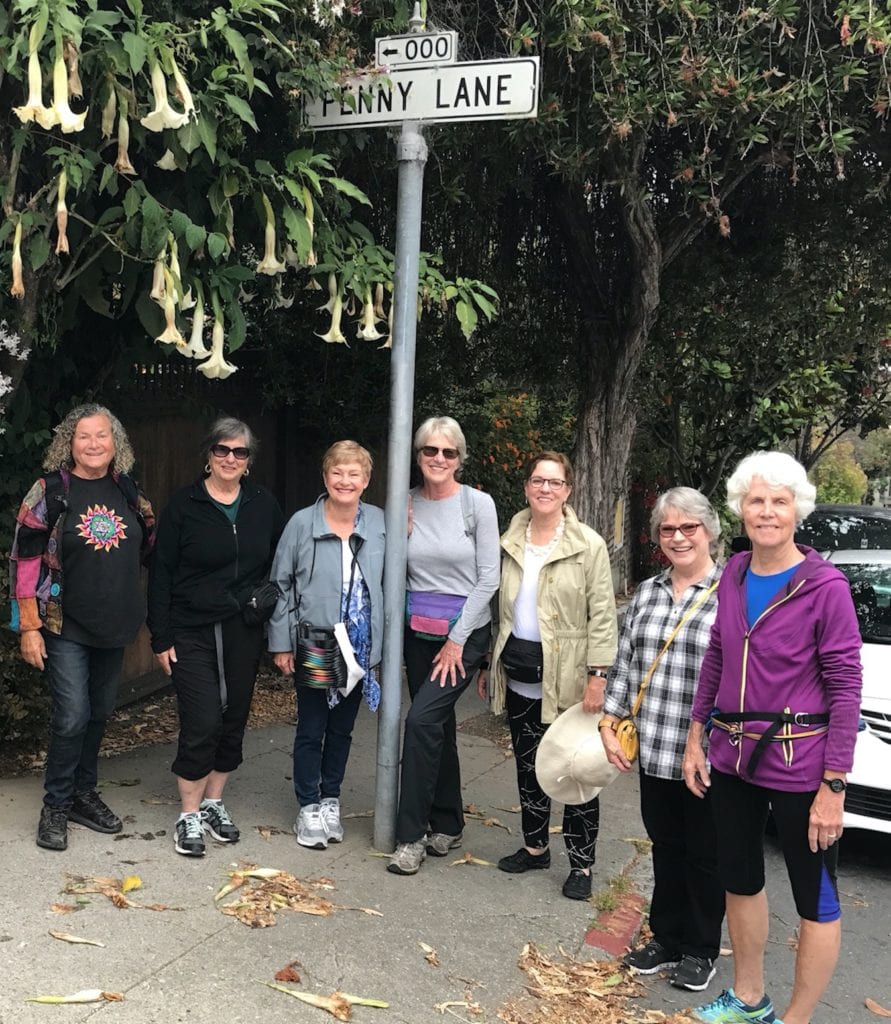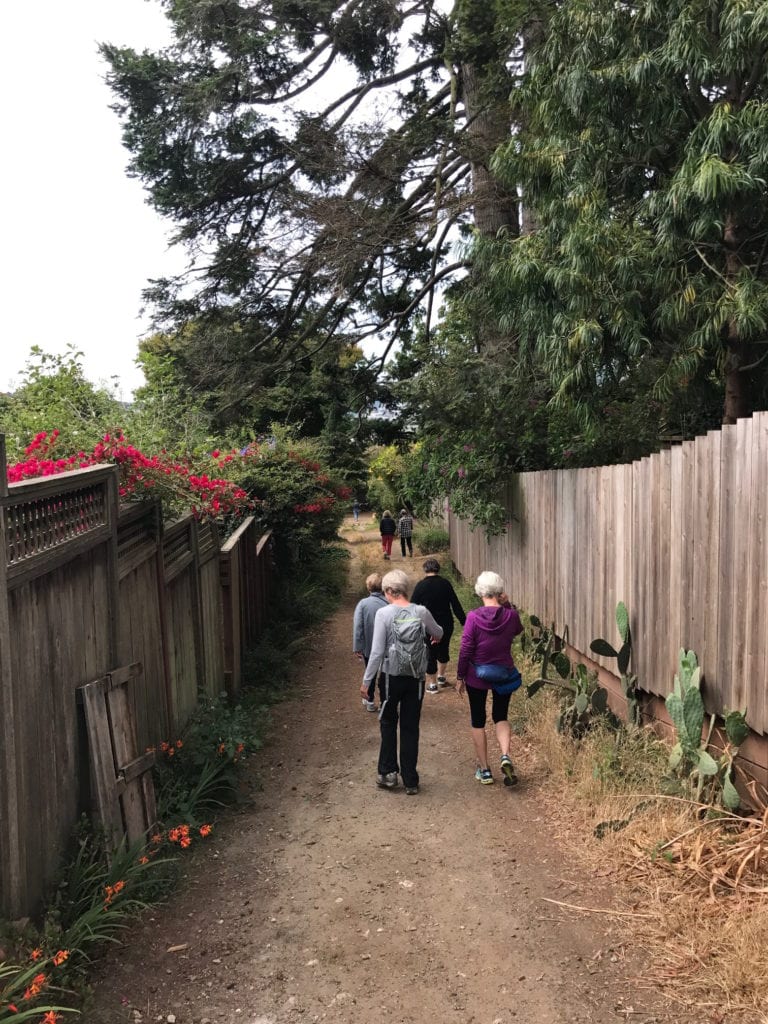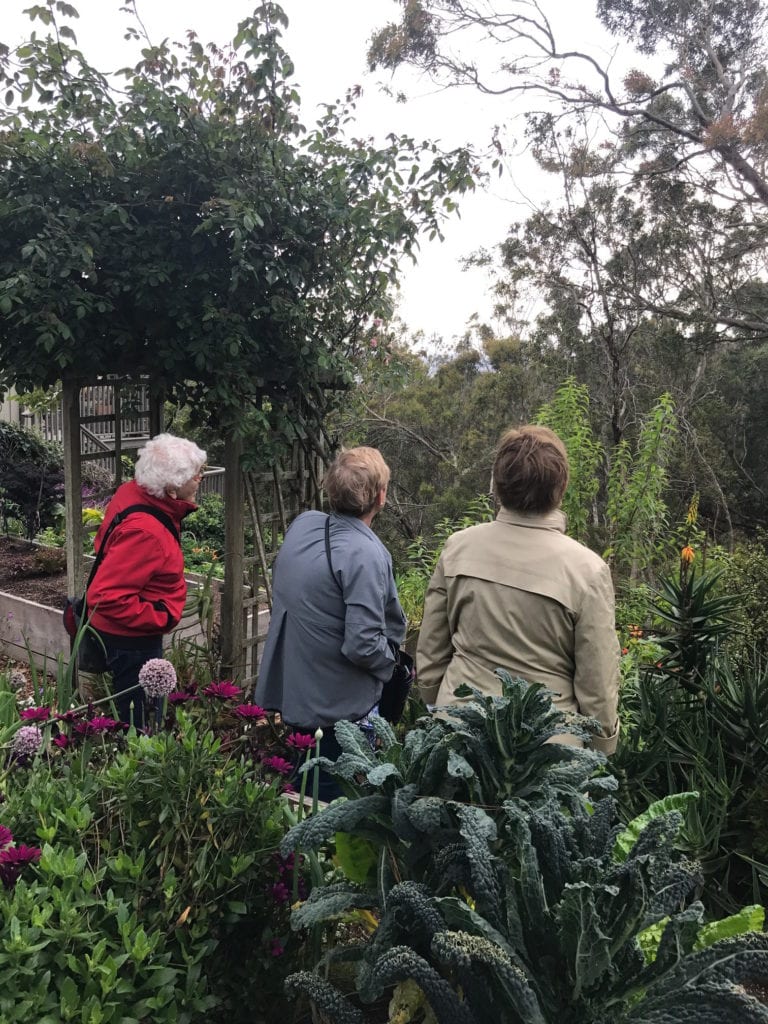
Story and photos by Murray Schneider
In 1967, as a freshly minted and struggling high school teacher only a few years older than my oldest student, I thought about leaving the classroom and becoming a tour guide. Instead, I stayed put and didn’t turn in my U.S. History textbook.
Fifty years later I finally got my wish – I became a guide.
I met Chris Greene when I did research for a recent Glen Park News article about World War II Japanese American relocation camps.
Chris’s a volunteer docent at the Presidio Officer’s Club, which mounted an exhibit called “Exclusion: The Presidio’s Role in World War II Japanese American Incarceration.”
Chris Greene taught American history, too and we bonded, which U.S. history teachers have a tendency to do.

“The First Friday Walkers group started in 2012,” Chris emailed. “It’s made up of a core group of 10 members who meet once a month and explore San Francisco neighborhoods.”
Chris, who lives in the Marina District, went on to describe how the 10 women had been on 40 walks, taking them to Hayes Valley, the Haight Ashbury, Cole Valley, Bernal Heights and the Mission, how each month another woman is charged with organizing the walk, and how they meet for coffee before, then lunch after each walk.
“How’d you like to be our tour guide?” Chris said. She didn’t have to ask twice.
“We’ll meet at Tyger’s Coffee Shop, an old-timey establishment,” Chris emailed her FFW friends about Glen Park’s village diner, a quintessential ‘third place,’ where neighbors gather over scrambled eggs, pancakes and omelets.
So on August 4 the ladies assembled at Tyger’s, leaning over hot cakes, toast and coffee.
Nancy Slepicka is a retired country newspaper owner and proprietor of an independent bookstore. Recently relocated from the Midwest, she’s now settling in to Bernal Heights.
“I moved to San Francisco four years ago from Hillsboro, Illinois, a town of 5,000,” Nancy emailed just hours after the walk. “Places such as Glen Park and Bernal Heights feel like home, and Tyger’s seems small town, a family café filled with friendly folks, simple menu, good food, quick service, low prices.”

“It’s about community,” continued Nancy, who doubled down as a reporter for her family newspaper, the Montgomery County News that her great-grandfather bought in 1892. Community has factored in varied roles in Nancy’s life. She volunteered in January 2006 with Habitat for Humanity, five months after Hurricane Katrina. Nancy, with her late husband, Richard, assisted in building numerous houses in rural Louisiana.
No better place, then, to begin our exploration of Glen Park community than Penny Lane. Sandwiched between Surrey and Sussex Streets, the rutted easement was once a nineteenth century carriage path but over the last decade has been spruced up by neighbors with an assortment of California native plants.
Entering the Sierra Nevada-like pathway from Surrey Street, bookended by Surrey and Sussex house backyards, Eleanor Laney greeted habitat-friendly plants and took a breath. “This is pollinator heaven,” she said. Eleanor lives in Palo Alto and possesses an unflagging interest in Monarch butterfly preservation.
Looking about her, she said, “A miracle, the good works of neighbors establishing this lane.”
The nine women wandered along the pockmarked path, breaking into duets, singing the praises of books enjoyed, films seen, travels planned, museums visited and symphonies attended.
At Diamond Street, I gathered them beneath the Penny Lane street sign for a photograph.
“It seemed so appropriate to have a group of women from the 60’s pose on Penny Lane during the Summer of Love’s 50th anniversary,” Eleanor emailed later.
We then crossed Diamond Street at Sussex Street and headed for doppelganger Ohlone Way, destined for Elk Street and the new Recreation Center. On Ohlone Way they paired up again, a sorority of sisters as interested in swapping stories as surrendering to scenery.
On Elk Street, beneath the Holstein cow sign at the park entrance, I told them about canyon cows and dynamite factories, about Islais Creek and Franciscan chert rock. The sorts of anecdotes that history teachers hoodwink their students into knowledge with; the sorts of stories with which Evelyn Rose and Amy O’Hair of the Glen Park Neighborhood History Project excel.
Oskar Rosas, a Recreation and Park Director, met us at the Rec Center. He led the way through the remodeled facility. He showed the ladies the refinished gymnasium and escorted them along the hall, showing them the rock wall where Silver Tree day campers climbed and repelled.
“The Recreation Center is a gem in the Glen Park crown” Eleanor Laney emailed. “Our group was touched to learn from Mr. Rosas that parents who had been campers at Silver Tree now give the same gift to their children.”
Exiting the Rec Center, the women were presented with another gift – nearly 70 acres of significant natural wilderness, courtesy of Recreation and Park’s Natural Resources Division.
Earlier, Chris Greene had emailed her friends: “The Rec Center is the entry to the canyon where we will walk about a mile loop on its floor. It’s mostly flat and gorgeous – all shady forest, burbling creek and riparian plants, carefully tended by the city parks department and neighborhood volunteers.”
We strolled along Alms Road. Islias Creek trickled to our left, canopied by Arroyo willow. Pink flowering currant, wax myrtle and red elderberry blossomed amongst it. Sloped grass lands shadowed us to our right, marbled with coyote brush. California oak dotted the hillside. Chert rock outcrops perforated the ridge, camouflaging Berkeley Way and Crags Court.
I told the women of the Natural Resources Division’s riparian restoration efforts, of its land management and stewardship mission. I told them of the Great horned dead owl Friends of Glen Canyon Park volunteers found in March 2016, victim of second generation rodenticide. I told them how coyotes still den here, how unleashed dogs can fall victim to these crafty creatures, and how a coyote was found this year at Douglass Playground, another victim of rodent poisoning.
Beyond the boardwalk and the seep, where pumpkin spiders preen during Halloween, I told them how once this pristine landscape was threatened by transportation “visionaries” who wanted to construct a freeway through it, and how these transit gurus were thwarted by three neighborhood women, now honored by a trail, the Gum Tree Girls Trail, named for them.
It hit a bull’s eye with Nancy Slepicka, from the Land of Lincoln, who’d partnered with the Audubon Society to maintain a sanctuary for Illinois birds.
“It felt like home when I learned of the Rec & Park’s volunteer work,” she wrote. “My late husband and I were active volunteers in Montgomery County Natural Area Guardians (NAGs), restoring and preserving native Illinois prairies.”
We continued along Islais Creek, circling to its west bank. I pointed across the canyon to the house on Berkeley way where two fire fighters, Vincent Perez and Anthony Valerio, perished in 2011. Behind us stood a hollowed-out tree where Glenridge nursery school children had fashioned a make-believe fairy house. Continuing, we came to a cross-over bridge. A pile of willow branches blanketed the creek bank, a deterrent placed there by NRD’s gardener, Steve Phillips, as a means to curtail erosion. Back on Alms Road, so named because nineteenth century San Francisco horse carriages clattered along it to Laguna Honda Hospital, we eventually regained Elk Street.
Along Chenery Street the women jig sawed again.
I caught up with Sandy Hunt. She lives in North Beach and emailed two days afterward that she was “pleased the city had invested so much in making Glen Park such a sweet place to live.”
“It was a ‘trip’ to compare the neighborhood with where I live,” she wrote. “What a difference. The parking! You are allowed four hours, compared to our two. And I saw no tour busses or tourists. Where I live, I am aware of both, as well as the increasing number of homeless.”
“Fortunately,” Sandy continued, conjuring Columbus Avenue’s City Lights, “we have a bookstore like yours.”
The subject of Bird & Beckett Books and Records had arisen during lunch, once we’d returned to Tyger’s. Nancy Slepicka suggested the walking group make a donation to my favorite cause to show its appreciation.
“Buy a book at Bird & Beckett,” I said.
Across the table, Nancy nodded. A small newsstand/bookstore in her town was about to close in the late 80s and she and her husband decided to buy it, moving the Montgomery County News offices to the second floor. The couple renovated the main floor into a bookstore they named – So Many Books….and More.
“We had a lot of fun with the book store, hosting author signings and readings for children,” Nancy wrote. “When we retired in 2007 I placed a classified ad in the paper: ‘Always wanted to own a book store? Call Nancy.’ My phone rang at 8 a.m. One of our frequent customers, Barb Adams, said ‘Yes. Let’s talk.’”
“We sold the bookstore to Barb,” Nancy continued. “It was a win-win for Richard and me, as well as the town – every town should have a bookstore.”
Ten years later it’s still operating as Books & Moore, the surname of Barb Adams’ husband.
“Books and music were among Richard’s passion,” Nancy wrote. “So my first visit to Bird & Beckett, my favorite San Francisco bookstore, to listen to the Grant Levin Trio was an emotional evening.”
“I appreciate that Glen Park supports Bird & Beckett and the Glen Park News,” she continued. “It represents and reinforces the important sense of place that is essential to community.”
Lunch done, we stood, exchanging goodbyes. A few of the women peeled off but the day wasn’t quite over. Fifteen minutes later we arrived at the Crags Court Community Garden.
“Of course we loved the walk along the willow wrapped canyon and hearing your stories about the barn owls and other canyon fauna,” Eleanor Laney wrote one day after the walk, “but the cherry on top of our Glen Canyon day was the visit to the Crags Court’s garden.”
The secret garden is cushioned atop Glen Canyon, and the best way to arrive is by foot.
Eleanor wrote:
“Perched unexpectedly on a steep hill, the well-tended garden is blessed with the perfect climate, sun, water, breeze as evidenced by the robust health of ALL the plants. Raised beds of huge and colorful dahlias, speckled lettuce, cascading clematis were all enhanced by the gently falling summer drizzle.”
On a warm summer’s day this August, the ladies of the First Friday Walkers penned another chapter in Glen Park history. They personalized it in a signature style.